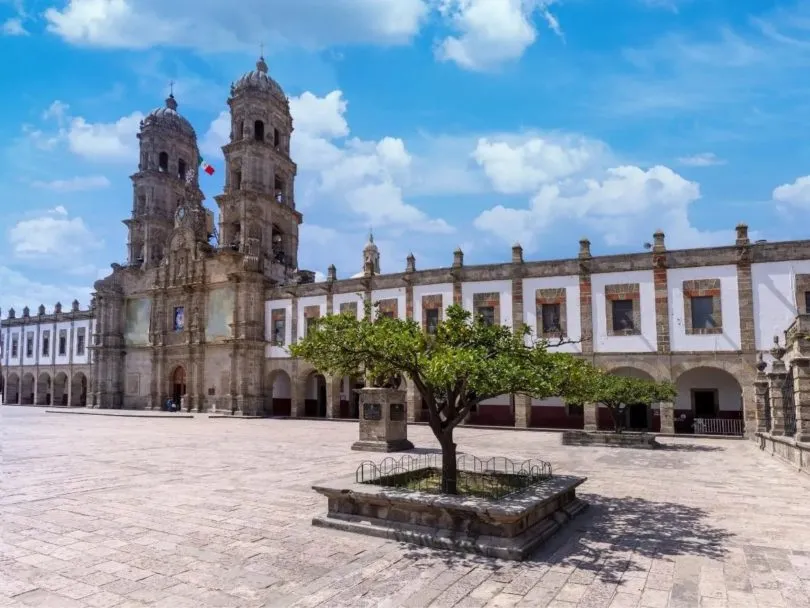
Introduction
The Basilica of Our Lady of Zapopan (Spanish: Basílica de Nuestra Señora de Zapopan) and Monastery of Our Lady of Zapopan is a 17th-century Franciscan sanctuary built in downtown Zapopan, Jalisco, Mexico. It is one of the most visited sanctuaries in western Mexico and houses the Wooden Madonna, considered a valuable relic of medieval origin, brought to New Galicia from Spain in the 16th century. The Huichol Museum is in the building.
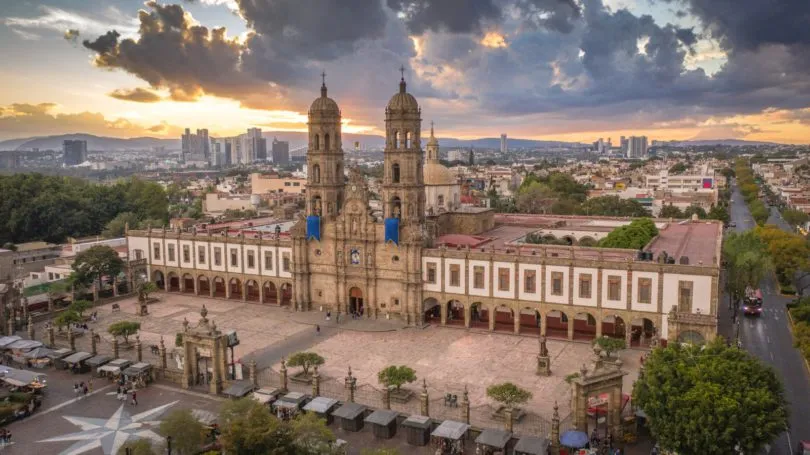
In early days the village of Zapopan was a feudal district and tributary of the powerful King of Tonala. In those days the Indians of the district worshiped an idol called Teopintzintl, “The Child God,” to which they offered gifts of hare and partridge. When the kingdom of Tonala bowed to Nuno de Guzman in 1530, Zapopan came under Spanish dominion. The Indian queen, Chihuapili Tzapotzinco, ordered all the chieftains under her rule to render their obedience to the Spanish Crown, and in March of 1530 the cacique of Atemajac, under whose jurisdiction lay Zapopan, complied with this order. The Mixton War of 1541, however, depopulated the district, and the encomendero of Tlaltenango, Francisco de Bobadilla, obtained the Viceroy’s permission to repopulate Zapopan with Indians from Tlaltenango, thus lessening the chance of another uprising.
On the eighth of December, 1541, the pueblo of Zapopan was resettled in accordance with the agreement, and on that day the Franciscan Fray Antonio de Segovia gave to the newly settled colony a small image of Our Lady of the Immaculate Conception. For ten years it had accompanied him on his apostolic journeys. In fact, only a short while before, while the Mixton War was still in progress, Fray Antonio, with his missionary companion Fray Miguel de Bolonia, had gone among the warring Indians, the image about his neck, exhorting them to make peace with the Spaniards. It is related that while Fray Antonio was preaching, the Indians saw luminous rays issuing from the image of Our Lady, and that this fact, as much as his preaching, caused them to stop fighting. In thirty-six hours Fray Antonio de Segovia brought to the Viceroy for pardon more than six thousand Indians, who had laid down their arms. From that time Fray Antonio called the image La Pacificadora, “She Who Makes Peace.”
Yet we must remember that it has the honor of being the first image of the Virgin Mary venerated in the State of Jalisco, and that it has seen the Church in that part of Mexico grow from the tiniest seed to the great, many-branched tree of the present-day Catholic Faith. Extensive construction of the abbey and cathedral began in 1689, but the original project was changed. Additions and transformations will occur over time.Over the years, the significance of the Virgin of Zapopan grew, becoming a symbol of hope and protection for the people of Mexico. The basilica played an important role in the country’s history, serving as a refuge for the faithful during times of war and turmoil. Despite facing natural disasters and political upheavals, the basilica was consistently restored and expanded to its current grandeur, a testament to the unwavering faith and dedication of its followers.
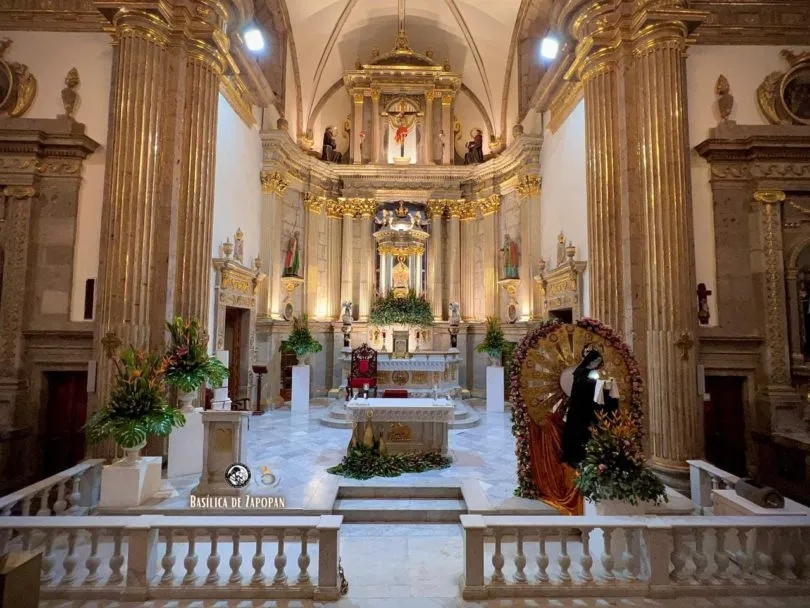
It is one of the main religious centres in the country, its construction dating back to the 17th century. Inside it has Doric style colonial altarpieces, the ceiling is gothic style, the main altarpiece in Corinthian style; the construction began in 1690 and ended in 1730.The original towers were demolished in 1889 and the current towers were finished in 1892 and they display rich ornaments, stone grooved columns, and large flower urns. The frontage is plateresque style. The basilica is a monumental example of 17th century colonial Baroque architecture, and is surrounded by other Spanish colonial architecture. The façade of the Basilica of Our Lady of Zapopan is a unique mix of Baroque and Churrigueresque styles. The facade has three gates and 117 niches that house statues of various saints. The central gate leads to the richly decorated atrium, where visitors can admire the intricate stonework and sculptures. As you enter the basilica, you are welcomed by a stunning view of the nave. The interiors of the basilica boast impeccable artwork and sculptures. The ceiling paintings narrate the story of Our Lady of Zapopan, while the side chapels are dedicated to different saints and angels. The impressive altarpiece behind the main altar is adorned with gold and silver laced with precious stones.
Next to the main altar is the Chapel of the Virgin of Zapopan, where the revered statue of Our Lady of Zapopan is kept. The Chapel has a Baroque design and is considered a highlight of the basilica. The statue of the Virgin is bedecked with jewels and adorned with flowers by the faithful. The basilica is also home to an exquisite collection of altarpieces. The altarpieces are located in the side chapels and exhibit the master craftsmanship of Mexican artists. The most renowned one is the “Altarpiece of the Immaculate Conception,” which is made entirely of gold. In a nutshell, the Basilica of Our Lady of Zapopan is a testimony to the Mexican baroque architecture and art. The front of the church has a great vestibule, with Spanish Baroque portals that feature Ionic columns, sculptured reliefs, and large urns on pedestals. The windows of the priest’s rooms are on the side of the church. The main altar is made of Italian marble from Carrara. The pedestal for the statue of the Virgin was made of cypress by local artisans in the 17th century. The interior of the abbey has lodgings on the first and second floor and a chapel for the priests. There are also meditation gardens. The basilica serves as a seminary and a center of religious instruction for the Franciscans
Our Lady of Zapopan
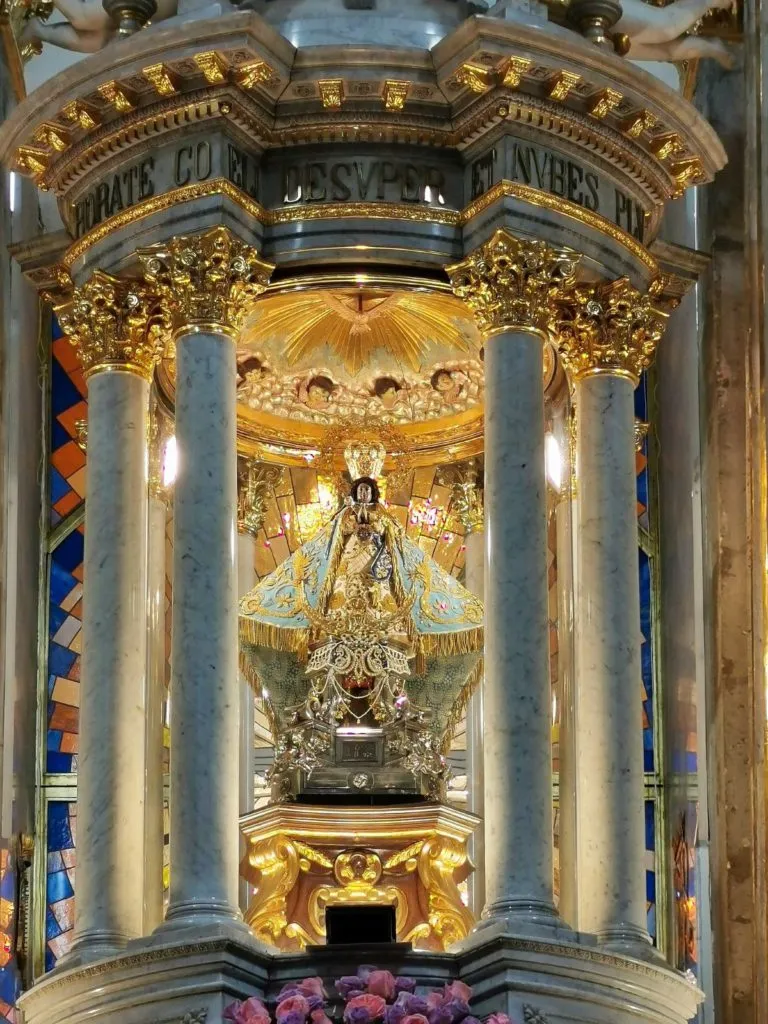
In its sculptured form, the statue represents Our Lady standing with her feet upon a rudely formed crescent moon. She wears a red tunic and a dark blue mantle outlined in gold. The eyes are painted, and the somewhat thick lips are closed.
History of Our Lady of Zapopan
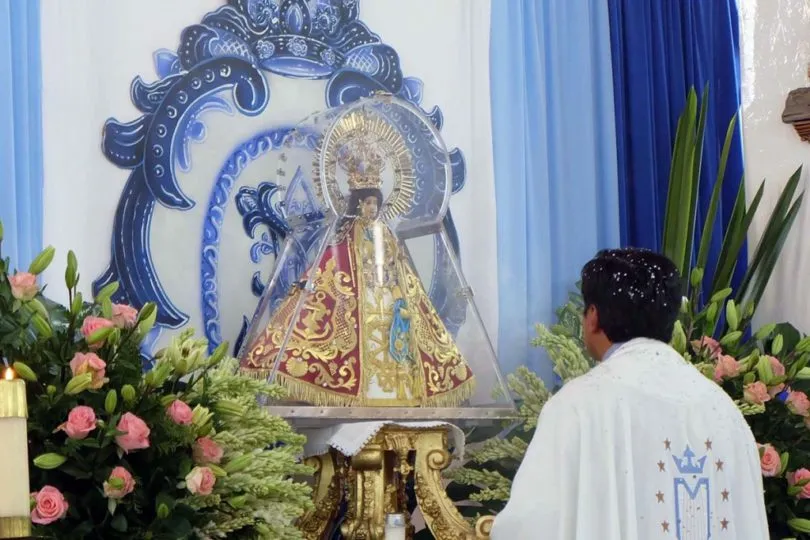
“The Little Virgin” or Our Lady of Zapopan is Spanish in origin, but completely Mexican in the tradition of more than four hundred years that surround her cult. Brought to Zapopan by Father Antonio de Segovia in 1541, the “Little Virgin”, less than fourteen inches high, found herself in the heart of a territory, then called New Galicia, still under the conquest of Nue de Guzman. The precious statue, which the warm heart of the Mexican personifies, was the instrument by which Heaven vouchsafed to turn the fears and animosities of the natives into a confidence and love which enabled the zealous Franciscan to gather them into the fold of the Good Shepherd. It was Diego de Herrera, pastor of Zapopan from 1637, who first learned of the special regard in which the natives of Zapopan held the image. In 1653, after careful investigation of the facts, the Bishop of Guadalajara, Don Juan Ruiz Colmenero, issued a decretal declaring the image “miraculous” and appointing the eighteenth of December as the annual celebration of the Feast of Our Lady of the Expectation of Zapopan. Under this title the image is still venerated today.
There are other titles of Our Lady of Zapopan for which she is justly celebrated. These are: Patroness of Guadalajara, General of the Armies, and Queen of Jalisco. Each of the three has its proper history. The end of the seventeenth century saw Guadalajara scourged by a terrible epidemic. The Bishop ordered the statue of Our Lady of Zapopan to be carried in procession from its temple into the cathedral of Guadalajara. There is in the ecclesiastical archives a sworn testimonial from the medical profession in Guadalajara, certifying that, following this procession, the plague ceased at once. In 1721, with the onslaught of another plague, Our Lady’s image was again brought to Guadalajara and carried from one barrio to another, again affecting a cessation of the plague. Our Lady was also invoked for protection against the violent storms and lightning which threaten Guadalajara during the rainy season. For these and other reasons Our Lady of Zapopan was officially declared Patroness of Guadalajara specifically “against storms, lightning, and epidemics.” Accordingly, each year from 1734 up to the present day, Our Lady of Zapopan leaves her sanctuary on the thirteenth of June and all through the rainy season, until the fourth of October, visits the churches in every barrio of Guadalajara.
In 1821, the “Year of Independence,” the achievement of independence took place on the thirteenth of June, at the time Our Lady’s image was entering Guadalajara for her annual pilgrimage. Accordingly the government of Jalisco decided to commission Our Lady of Zapopan “General of the Army of the State.” On the fifteenth of September in that year, in the presence of the officials of both Church and State, the venerable image was vested in the blue shoulder sash and gold baston of a general. In 1852, while Guadalajara was in a state of siege, with the water supply of the city cut off, General Blancarte placed a new sash of rank on Our Lady of Zapopan and had a twenty-one-gun salute fired in her honour, revoking her as Patroness and General of the army of Jalisco. Once again the Virgin effectively protected her city. In 1894 the Governor of Jalisco made a similar proclamation, and bestowed a new sash upon the image. In the year 1919 Our Lady of Zapopan received a new honour, this time from the Vatican. On the seventeenth of June in that year, the Vatican Chapter decreed the canonical Coronation of Our Lady of Zapopan. The sacred image was solemnly invested with a golden crown in the cathedral of Guadalajara.
Description of Our Lady of Zapopan
The tiny statue of the Virgin, made from corn paste, is no more than 10 inches high. The image is made of pasta de Michoacan – pieces of cornstalk smoothed and cemented together by glue. It is little more than thirteen inches in height, and represents the Virgin Mary under her title of the Immaculate Conception. The original sculpture donated by Fray Antonio de Segovia consisted only of the upper half, it is believed, the lower section having been added at a later date. As the lower half is not in proportion to the upper, the reconstruction gives a stunted effect to the image. However, since the original sculptured garments nowadays are always covered with rich vestments of fabric, the disproportion is not apparent. In its sculptured form, the statue represents Our Lady standing with her feet upon a rudely formed crescent moon. She wears a red tunic and a dark blue mantle outlined in gold. The eyes are painted, and the somewhat thick lips are closed.
Artwork
The church has a collection of art that includes paintings and sculptures. The oil painting of Juan Cruz Ruiz de Cabañas y Crespo, who was a patron of the church. The statue of the Virgin made by local artisans from Michoacán, at the request of Fr. Antonio de Segovia in 1541.The Holy Family – a work by Victoriano Acuña (1832) The church’s atrium features two bronze statues; one of Fr. Antonio de Segovia and of Pope John Paul II. The Huichol Museum is next to the basilica and has a permanent exhibit about the art of the Huichol, Tepehuan and Cora people. The Museum of the Virgin of Zapopan is on the north side of the basilica next to where the Virgin is venerated.
Romeria—Pilgrimage
The Romeria of the Virgin of Zapopan is an annual pilgrimage from the Guadalajara Cathedral to the Basilica of Zapopan. The Romería of the Virgin of Zapopan consists of a route 8 km in length, from the metropolitan Guadalajara Cathedral, to the Basilica of Our Lady of Zapopan. The pilgrimage of the Virgin of Zapopan is the name given to the annual journey that takes place on the morning of Oct. 12 from the Cathedral of Guadalajara to the Basilica of Zapopan. With a procession of Catholics , priests and seminarians carrying the statue of Our Lady from the cathedral to the basilica.This is a tradition that stems from 1634. At dawn on October 12 of each year a procession of lay Catholics, pre-Columbian dancers, mendicants, priests and seminarians carries a statue of the Virgin Mary from the cathedral to the basilica. The figure of the virgin goes accompanied by more than 1,000,000 people. This festival involves most of the population of both cities and finishes with a mass in the plaza outside the basilica. The event ends with traditional dances and evening fireworks. At the end of her journey, Our Lady of Zapopan makes the last five-mile trek from Guadalajara Cathedral to Zapopan on a flower-filled float. It’s a lavish procession, with Indian dancers, cowboys and marching bands. Many devoted pilgrims follow behind her on their knees.The whole celebration is one of Mexico’s largest and most important. The highlight of this event is that UNESCO inscribed Romeria—pilgrimage in 2018 on the Representative List of the Intangible Cultural Heritage of Humanity. This shows that our lady of Zapopan has not only a great spiritual characteristic but also a great culture that can be cherished by us.
Feast Day
Feast day – 12th October
Mass Timing
Monday to Friday : 7:00 AM, 8:00 AM, 9:00 AM, 11:00 AM, 1:00 PM, 8:00 PM.
Saturday : 7:00 AM, 8:00 AM, 9:00 AM, 11:00 AM, 1:00 PM, 6:00 PM.
Sunday : 6:00 AM, 7:00 AM, 8:00 AM, 9:00 AM, 10:00 AM, 11:00 AM, 1:00 PM, 2:00 PM, 5:00 PM, 6:00 PM, 7:00 PM, 8:00 PM, 9:00 PM.
Church Opening Time:
Monday to Saturday : 6:00 AM, 9:00 PM.
Sunday : 5:00 AM, 10:00 PM.
Contact Info
Calle Eva Briseño
152, Zapopan, 44250 Zapopan,
Jalisco, Mexico
Phone No.
Phone: +52 33 3633 0141
Accommodations
How to reach the Sanctuary
Airport
The nearest Airport to Basilica of Our Lady of Zapopan is Guadalajara (GDL) which is just 27.6 km away from the Basilica
Railway
The nearest Railway Station to Basilica of Our Lady of Zapopan is Mercado Del Mar which is just 4 minutes walk away from the Basilica







